The Cambridge History of Japan, Vol. 3: Medieval Japan
Подождите немного. Документ загружается.

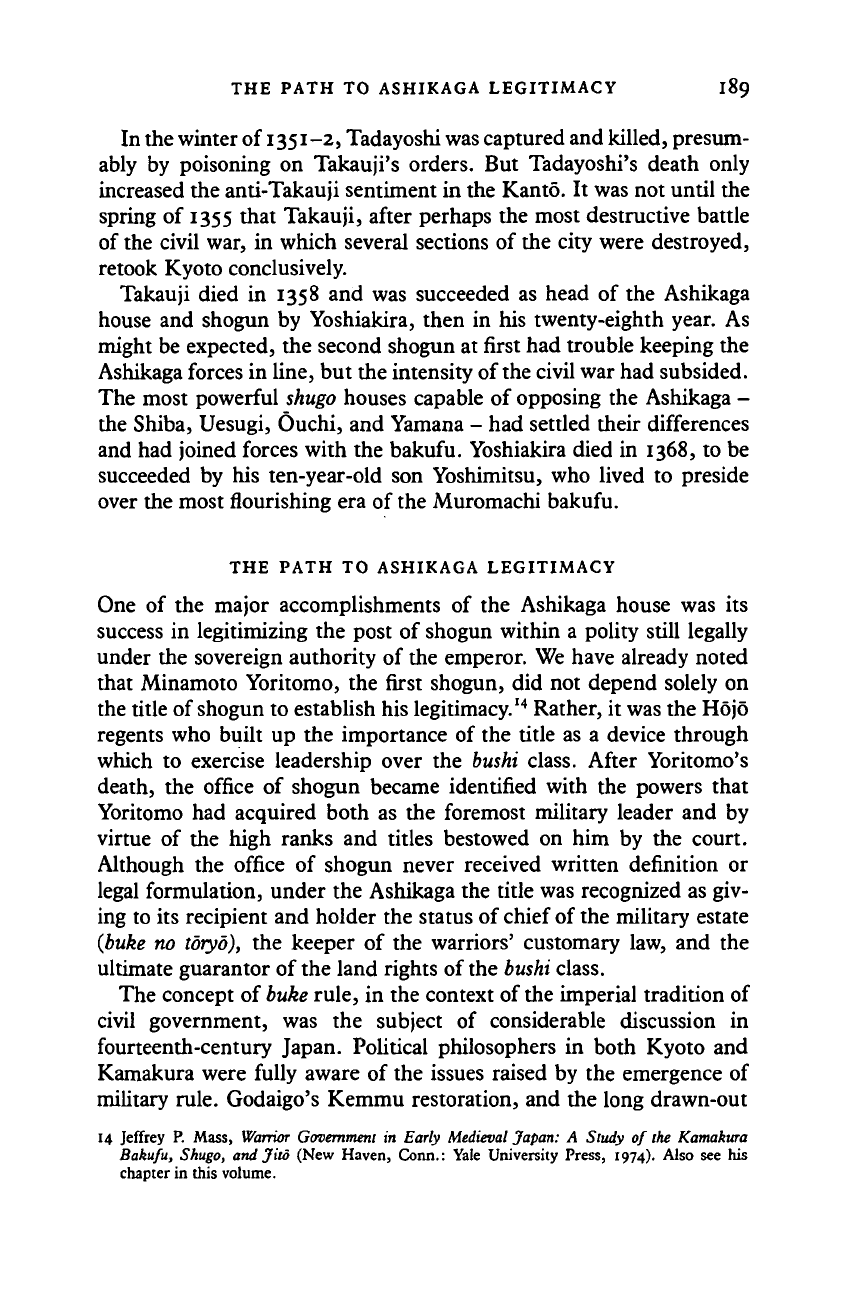
THE PATH TO ASHIKAGA LEGITIMACY 189
In the winter of 1351-2, Tadayoshi was captured and killed, presum-
ably by poisoning on Takauji's orders. But Tadayoshi's death only
increased the anti-Takauji sentiment in the Kanto. It was not until the
spring of 1355 that Takauji, after perhaps the most destructive battle
of the civil war, in which several sections of the city were destroyed,
retook Kyoto conclusively.
Takauji died in 1358 and was succeeded as head of the Ashikaga
house and shogun by Yoshiakira, then in his twenty-eighth year. As
might be expected, the second shogun at first had trouble keeping the
Ashikaga forces in line, but the intensity of the civil war had subsided.
The most powerful shugo houses capable of opposing the Ashikaga -
the Shiba, Uesugi, Ouchi, and Yamana - had settled their differences
and had joined forces with the bakufu. Yoshiakira died in 1368, to be
succeeded by his ten-year-old son Yoshimitsu, who lived to preside
over the most flourishing era of the Muromachi bakufu.
THE PATH TO ASHIKAGA LEGITIMACY
One of the major accomplishments of the Ashikaga house was its
success in legitimizing the post of shogun within a polity still legally
under the sovereign authority of the emperor. We have already noted
that Minamoto Yoritomo, the first shogun, did not depend solely on
the title of shogun to establish his legitimacy.
14
Rather, it was the Hojo
regents who built up the importance of the title as a device through
which to exercise leadership over the bushi class. After Yoritomo's
death, the office of shogun became identified with the powers that
Yoritomo had acquired both as the foremost military leader and by
virtue of the high ranks and titles bestowed on him by the court.
Although the office of shogun never received written definition or
legal formulation, under the Ashikaga the title was recognized as giv-
ing to its recipient and holder the status of chief of the military estate
(buke no toryo), the keeper of the warriors' customary law, and the
ultimate guarantor of the land rights of the bushi class.
The concept of buke rule, in the context of the imperial tradition of
civil government, was the subject of considerable discussion in
fourteenth-century Japan. Political philosophers in both Kyoto and
Kamakura were fully aware of the issues raised by the emergence of
military rule. Godaigo's Kemmu restoration, and the long drawn-out
14 Jeffrey P. Mass, Warrior Government in Early Medieval Japan: A Study of the Kamakura
Bakufu, Shugo, and Jito (New Haven, Conn.: Yale University Press, 1974). Also see his
chapter in this volume.
Cambridge Histories Online © Cambridge University Press, 2008
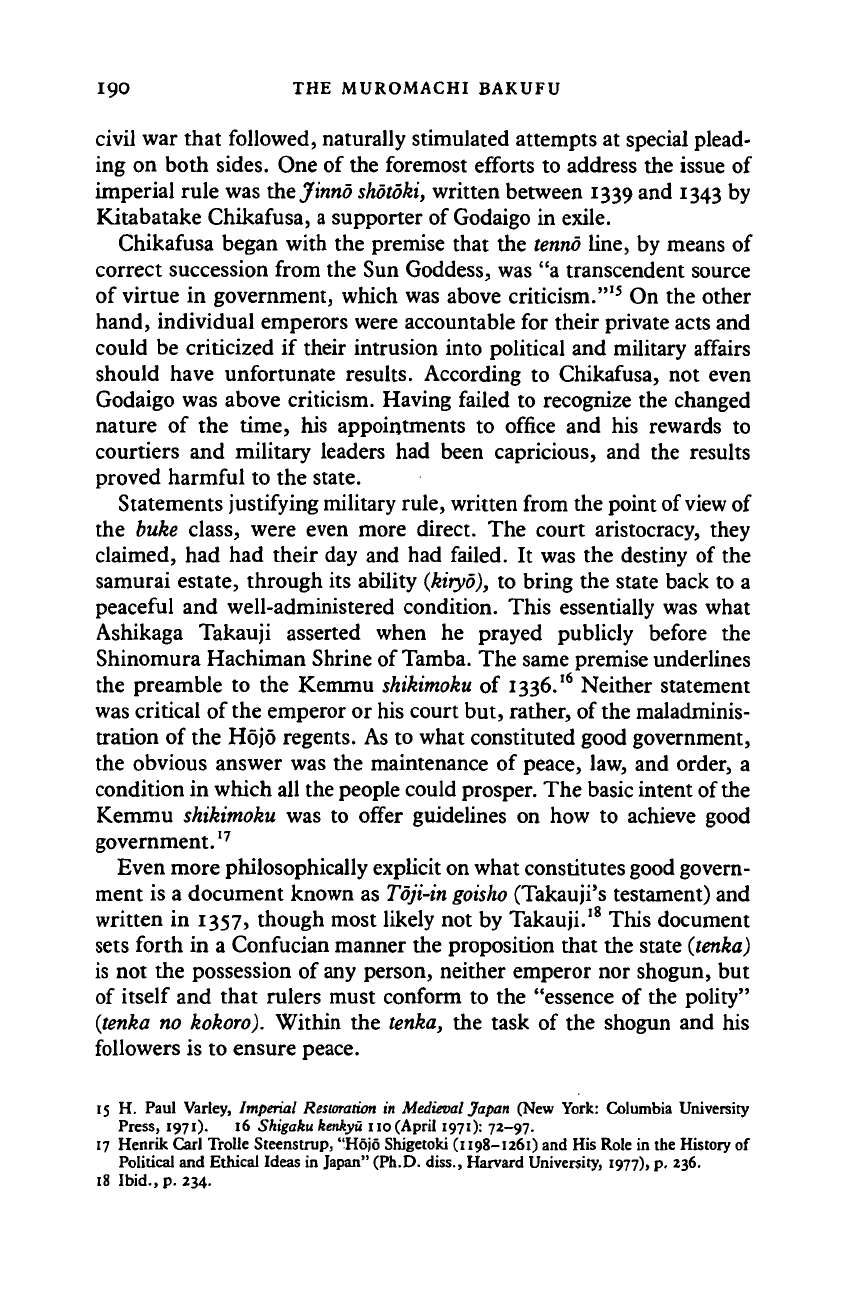
190 THE MUROMACHI BAKUFU
civil war that followed, naturally stimulated attempts at special plead-
ing on both sides. One of the foremost efforts to address the issue of
imperial rule was the Jinno
shotoki,
written between 1339 and 1343 by
Kitabatake Chikafusa, a supporter of Godaigo in exile.
Chikafusa began with the premise that the
tenno
line, by means of
correct succession from the Sun Goddess, was "a transcendent source
of virtue in government, which was above criticism."
15
On the other
hand, individual emperors were accountable for their private acts and
could be criticized if their intrusion into political and military affairs
should have unfortunate results. According to Chikafusa, not even
Godaigo was above criticism. Having failed to recognize the changed
nature of the time, his appointments to office and his rewards to
courtiers and military leaders had been capricious, and the results
proved harmful to the state.
Statements justifying military rule, written from the point of view of
the buke class, were even more direct. The court aristocracy, they
claimed, had had their day and had failed. It was the destiny of the
samurai estate, through its ability
(kiryd),
to bring the state back to a
peaceful and well-administered condition. This essentially was what
Ashikaga Takauji asserted when he prayed publicly before the
Shinomura Hachiman Shrine of
Tamba.
The same premise underlines
the preamble to the Kemmu
shikimoku
of 1336.
16
Neither statement
was critical of the emperor or his court but, rather, of the maladminis-
tration of the Hojo regents. As to what constituted good government,
the obvious answer was the maintenance of peace, law, and order, a
condition in which all the people could prosper. The basic intent of the
Kemmu shikimoku was to offer guidelines on how to achieve good
government.
17
Even more philosophically explicit on what constitutes good govern-
ment is a document known as
Toji-in goisho
(Takauji's testament) and
written in 1357, though most likely not by Takauji.
18
This document
sets forth in a Confucian manner the proposition that the state
(tenka)
is not the possession of any person, neither emperor nor shogun, but
of itself and that rulers must conform to the "essence of the polity"
(tenka no
kokoro).
Within the tenka, the task of the shogun and his
followers is to ensure peace.
15 H. Paul Varley, Imperial Restoration in Medieval Japan (New York: Columbia University
Press,
1971). 16 Shigaku
kenkyu
no (April 1971): 72-97.
17 Henrik Carl Trolle Steenstrup, "Hojd Shigetoki (1198-1261) and His Role in the History of
Political and Ethical Ideas in Japan" (Ph.D. diss., Harvard University, 1977), p. 236.
18 Ibid., p. 234.
Cambridge Histories Online © Cambridge University Press, 2008
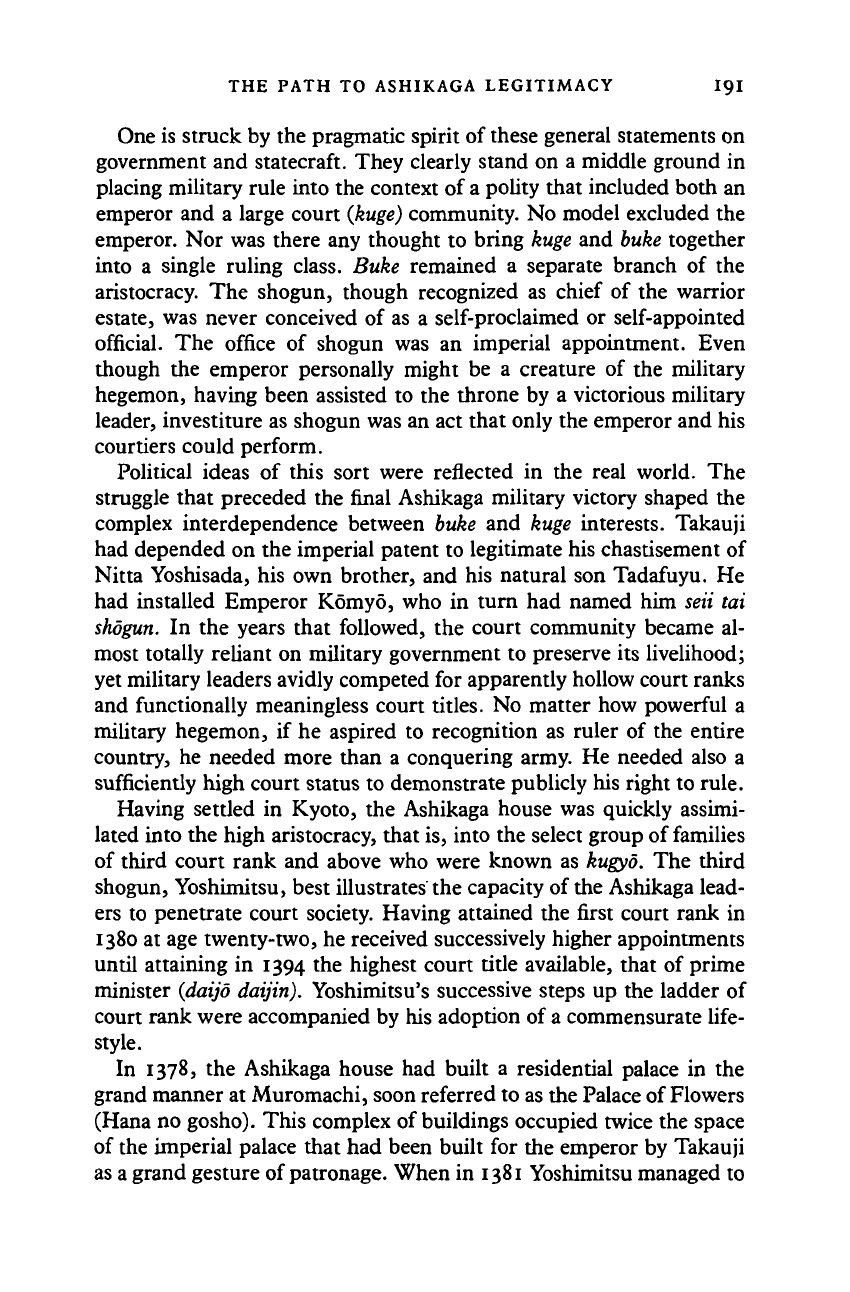
THE PATH TO ASHIKAGA LEGITIMACY I91
One is struck by the pragmatic spirit of these general statements on
government and statecraft. They clearly stand on a middle ground in
placing military rule into the context of
a
polity that included both an
emperor and a large court
(kuge)
community. No model excluded the
emperor. Nor was there any thought to bring
kuge
and
buke
together
into a single ruling class. Buke remained a separate branch of the
aristocracy. The shogun, though recognized as chief of the warrior
estate, was never conceived of as a self-proclaimed or self-appointed
official. The office of shogun was an imperial appointment. Even
though the emperor personally might be a creature of the military
hegemon, having been assisted to the throne by a victorious military
leader, investiture as shogun was an act that only the emperor and his
courtiers could perform.
Political ideas of this sort were reflected in the real world. The
struggle that preceded the final Ashikaga military victory shaped the
complex interdependence between buke and kuge interests. Takauji
had depended on the imperial patent to legitimate his chastisement of
Nitta Yoshisada, his own brother, and his natural son Tadafuyu. He
had installed Emperor Komyo, who in turn had named him seii tai
shogun.
In the years that followed, the court community became al-
most totally reliant on military government to preserve its livelihood;
yet military leaders avidly competed for apparently hollow court ranks
and functionally meaningless court titles. No matter how powerful a
military hegemon, if he aspired to recognition as ruler of the entire
country, he needed more than a conquering army. He needed also a
sufficiently high court status to demonstrate publicly his right to rule.
Having settled in Kyoto, the Ashikaga house was quickly assimi-
lated into the high aristocracy, that is, into the select group of families
of third court rank and above who were known as
kugyo.
The third
shogun, Yoshimitsu, best illustrates the capacity of the Ashikaga lead-
ers to penetrate court society. Having attained the first court rank in
1380 at age twenty-two, he received successively higher appointments
until attaining in 1394 the highest court title available, that of prime
minister
(daijd
daijin).
Yoshimitsu's successive steps up the ladder of
court rank were accompanied by his adoption of
a
commensurate life-
style.
In 1378, the Ashikaga house had built a residential palace in the
grand manner at Muromachi, soon referred to as the Palace of Flowers
(Hana no gosho). This complex of buildings occupied twice the space
of the imperial palace that had been built for the emperor by Takauji
as
a
grand gesture of patronage. When in 1381 Yoshimitsu managed to
Cambridge Histories Online © Cambridge University Press, 2008
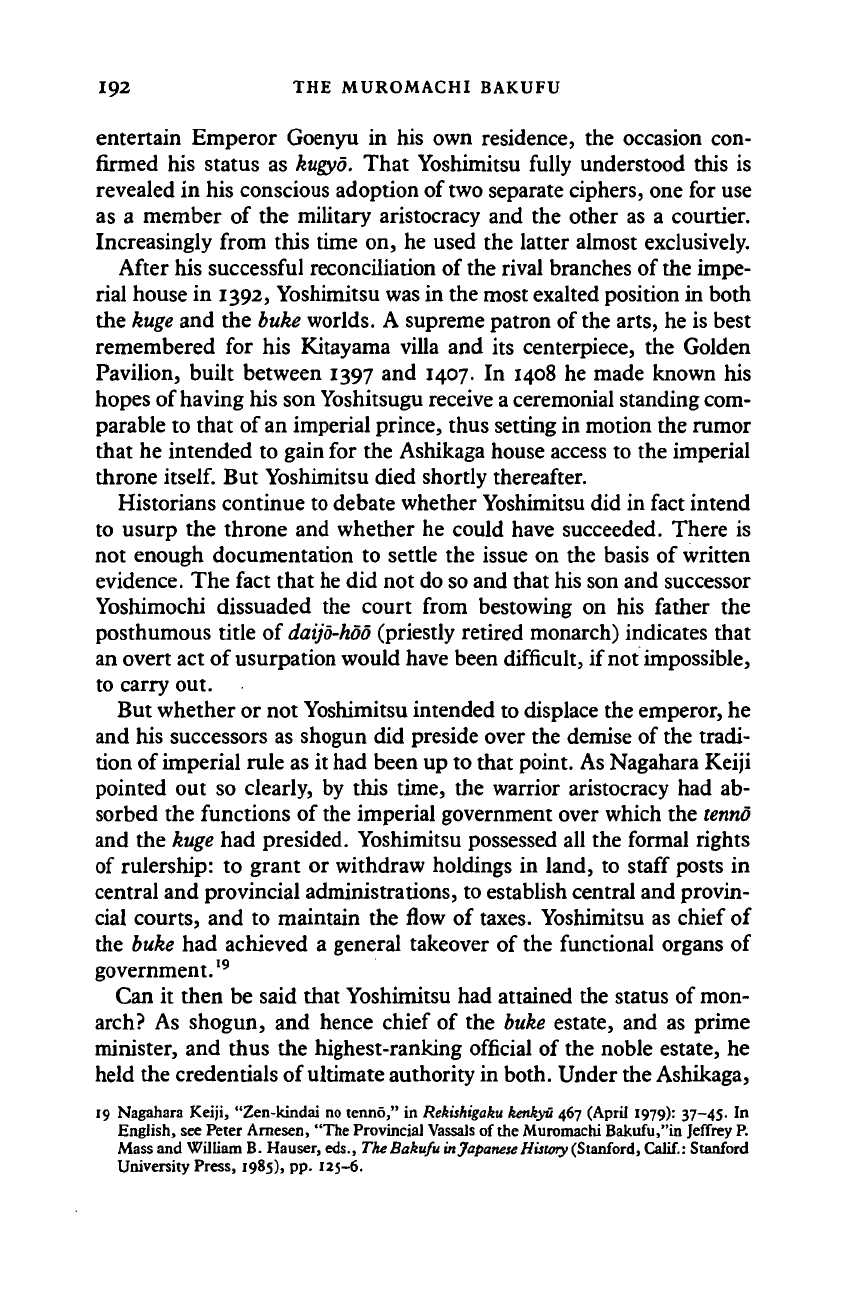
192
THE
MUROMACHI BAKUFU
entertain Emperor Goenyu
in his own
residence,
the
occasion
con-
firmed his status
as
kugyo.
That Yoshimitsu fully understood this
is
revealed
in his
conscious adoption
of
two
separate ciphers,
one for use
as
a
member
of the
military aristocracy
and the
other
as a
courtier.
Increasingly from this time
on, he
used
the
latter almost exclusively.
After
his
successful reconciliation
of
the
rival branches
of
the impe-
rial house
in
1392, Yoshimitsu was
in the
most exalted position
in
both
the
kuge
and the
buke worlds.
A
supreme patron
of
the
arts,
he is
best
remembered
for his
Kitayama villa
and its
centerpiece,
the
Golden
Pavilion, built between
1397 and 1407. In 1408 he
made known
his
hopes of having his son Yoshitsugu receive
a
ceremonial standing com-
parable
to
that
of
an imperial prince, thus setting
in
motion
the
rumor
that
he
intended
to
gain
for the
Ashikaga house access
to the
imperial
throne
itself. But
Yoshimitsu died shortly thereafter.
Historians continue to debate whether Yoshimitsu
did in
fact intend
to usurp
the
throne
and
whether
he
could have succeeded. There
is
not enough documentation
to
settle
the
issue
on the
basis
of
written
evidence.
The
fact that he
did not do
so
and
that his
son and
successor
Yoshimochi dissuaded
the
court from bestowing
on his
father
the
posthumous title
of
daijo-hoo
(priestly retired monarch) indicates that
an overt
act
of usurpation would have been difficult, if not impossible,
to carry
out.
But whether
or not
Yoshimitsu intended
to
displace the emperor,
he
and
his
successors
as
shogun
did
preside over
the
demise
of
the tradi-
tion of imperial rule
as it
had been
up to
that point. As Nagahara Keiji
pointed
out so
clearly,
by
this time,
the
warrior aristocracy
had ab-
sorbed
the
functions
of
the imperial government over which
the
tenno
and
the
kuge
had
presided. Yoshimitsu possessed
all the
formal rights
of rulership:
to
grant
or
withdraw holdings
in
land,
to
staff posts
in
central
and
provincial administrations, to establish central
and
provin-
cial courts,
and to
maintain
the
flow
of
taxes. Yoshimitsu
as
chief of
the buke
had
achieved
a
general takeover
of the
functional organs
of
government.
19
Can
it
then
be
said that Yoshimitsu
had
attained
the
status
of
mon-
arch?
As
shogun,
and
hence chief
of the
buke estate,
and as
prime
minister,
and
thus
the
highest-ranking official
of the
noble estate,
he
held
the
credentials of ultimate authority
in
both. Under the Ashikaga,
19 Nagahara Keiji, "Zen-kindai
no
tenno,"
in
Rekishigaku kenkyu
467 (April 1979): 37-45.
In
English,
see
Peter Amesen, "The Provincial Vassals
of
the Muromachi Bakufu,"in Jeffrey P.
Mass
and
William B. Hauser, eds., TheBakufu in Japanese
History
(Stanford,
Calif.:
Stanford
University Press, 1985),
pp.
125-6.
Cambridge Histories Online © Cambridge University Press, 2008
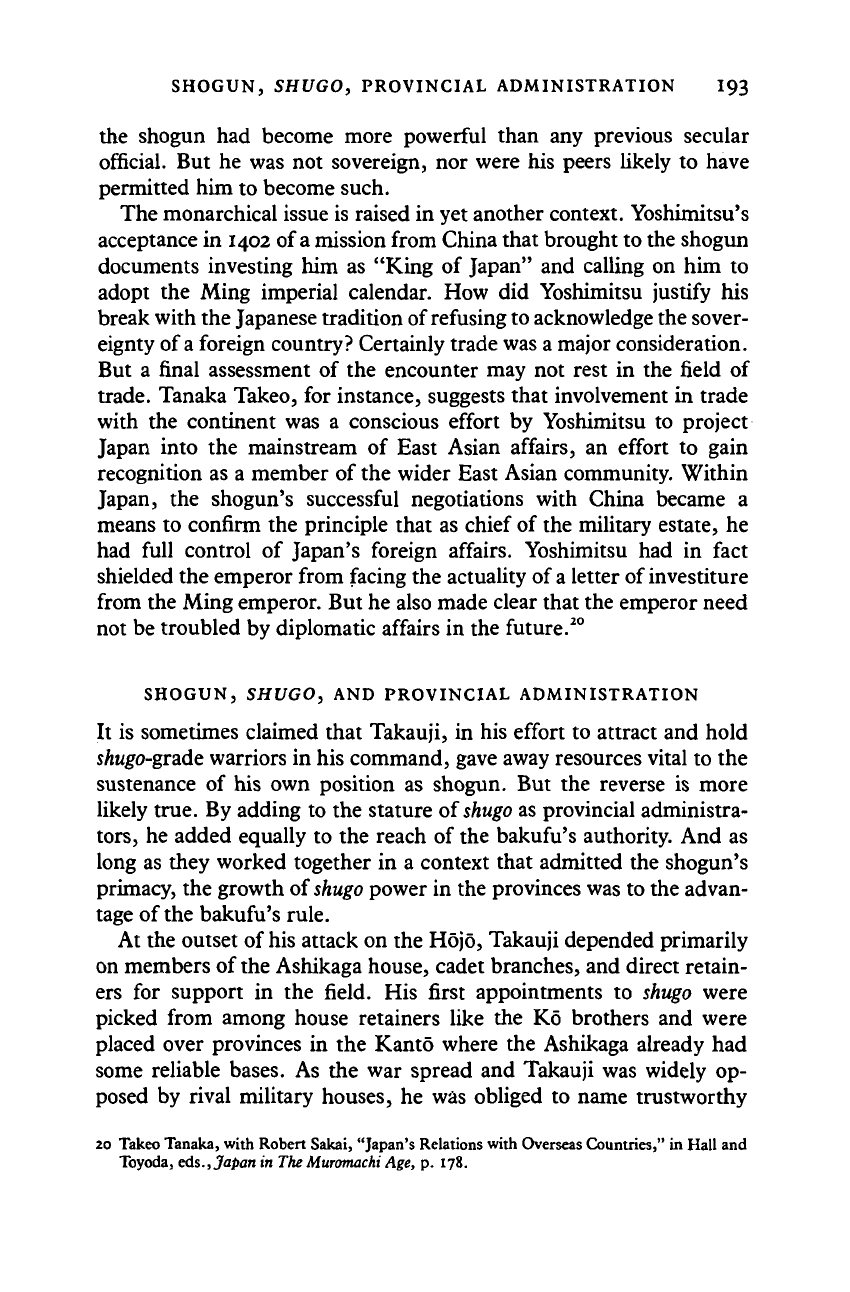
SHOGUN, SHUGO, PROVINCIAL ADMINISTRATION 193
the shogun had become more powerful than any previous secular
official. But he was not sovereign, nor were his peers likely to have
permitted him to become such.
The monarchical issue is raised in yet another context. Yoshimitsu's
acceptance in 1402 of a mission from China that brought to the shogun
documents investing him as "King of Japan" and calling on him to
adopt the Ming imperial calendar. How did Yoshimitsu justify his
break with the Japanese tradition of refusing to acknowledge the sover-
eignty of a foreign country? Certainly trade was a major consideration.
But a final assessment of the encounter may not rest in the field of
trade. Tanaka Takeo, for instance, suggests that involvement in trade
with the continent was a conscious effort by Yoshimitsu to project
Japan into the mainstream of East Asian affairs, an effort to gain
recognition as a member of the wider East Asian community. Within
Japan, the shogun's successful negotiations with China became a
means to confirm the principle that as chief of the military estate, he
had full control of Japan's foreign affairs. Yoshimitsu had in fact
shielded the emperor from facing the actuality of
a
letter of investiture
from the Ming emperor. But he also made clear that the emperor need
not be troubled by diplomatic affairs in the future.
20
SHOGUN, SHUGO, AND PROVINCIAL ADMINISTRATION
It is sometimes claimed that Takauji, in his effort to attract and hold
shugo-giadc
warriors in his command, gave away resources vital to the
sustenance of his own position as shogun. But the reverse is more
likely true. By adding to the stature ofshugo as provincial administra-
tors,
he added equally to the reach of the bakufu's authority. And as
long as they worked together in a context that admitted the shogun's
primacy, the growth of
shugo
power in the provinces was to the advan-
tage of the bakufu's rule.
At the outset of
his
attack on the Hojo, Takauji depended primarily
on members of the Ashikaga house, cadet branches, and direct retain-
ers for support in the field. His first appointments to
shugo
were
picked from among house retainers like the Ko brothers and were
placed over provinces in the Kanto where the Ashikaga already had
some reliable bases. As the war spread and Takauji was widely op-
posed by rival military houses, he was obliged to name trustworthy
20 Takeo Tanaka, with Robert Sakai, "Japan's Relations with Overseas Countries," in Hall and
Toyoda,
eds.,
Japan in The
Mwromachi
Age, p. 178.
Cambridge Histories Online © Cambridge University Press, 2008
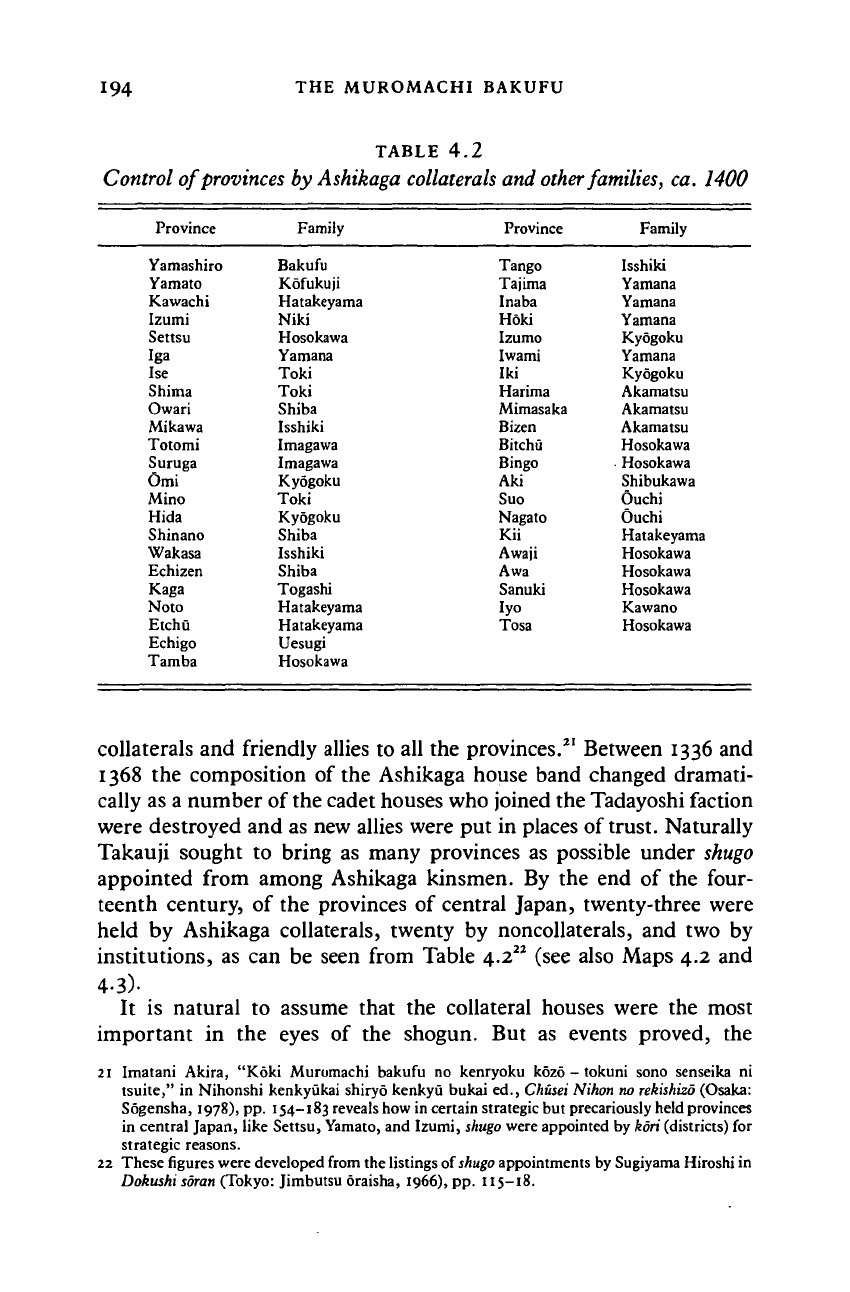
194
THE MUROMACHI BAKUFU
TABLE 4.2
Control of provinces by Ashikaga
collaterals
and other families, ca. 1400
Province
Yamashiro
Yamato
Kawachi
Izumi
Settsu
Iga
Ise
Shima
Owari
Mikawa
Totomi
Suruga
Omi
Mino
Hida
Shinano
Wakasa
Echizen
Kaga
Noto
Etchu
Echigo
Tamba
Family
Bakufu
Kofukuji
Hatakeyama
Niki
Hosokawa
Yamana
Toki
Toki
Shiba
Isshiki
Imagawa
Imagawa
Kyogoku
Toki
Kyogoku
Shiba
Isshiki
Shiba
Togashi
Hatakeyama
Hatakeyama
Uesugi
Hosokawa
Province
Tango
Tajima
Inaba
Hoki
Izumo
Iwami
Iki
Harima
Mimasaka
Bizen
Bitchu
Bingo
Aki
Suo
Nagato
Kii
Awaji
Awa
Sanuki
Iyo
Tosa
Family
Isshiki
Yamana
Yamana
Yamana
Kyogoku
Yamana
Kyogoku
Akamatsu
Akamatsu
Akamatsu
Hosokawa
Hosokawa
Shibukawa
Ouchi
Ouchi
Hatakeyama
Hosokawa
Hosokawa
Hosokawa
Kawano
Hosokawa
collaterals and friendly allies to all the provinces.
21
Between 1336 and
1368 the composition of the Ashikaga house band changed dramati-
cally as a number of the cadet houses who joined the Tadayoshi faction
were destroyed and as new allies were put in places of trust. Naturally
Takauji sought to bring as many provinces as possible under
shugo
appointed from among Ashikaga kinsmen. By the end of the four-
teenth century, of the provinces of central Japan, twenty-three were
held by Ashikaga collaterals, twenty by noncollaterals, and two by
institutions, as can be seen from Table 4.2" (see also Maps 4.2 and
4-3).
It is natural to assume that the collateral houses were the most
important in the eyes of the shogun. But as events proved, the
21 Imatani Akira, "Koki Muromachi bakufu no kenryoku kozo - tokuni sono senseika ni
tsuite," in Nihonshi kenkyukai shiryo kenkyu bukai ed., Chusei Nihon no rekishizo (Osaka:
Sogensha, 1978), pp. 154-183 reveals how in certain strategic but precariously held provinces
in central Japan, like Settsu, Yamato, and Izumi, shugo were appointed by kori (districts) for
strategic reasons.
22 These figures were developed from the listings of
shugo
appointments by Sugiyama Hiroshi in
Dokushi
soran
(Tokyo: Jimbutsu oraisha, 1966), pp. 115-18.
Cambridge Histories Online © Cambridge University Press, 2008
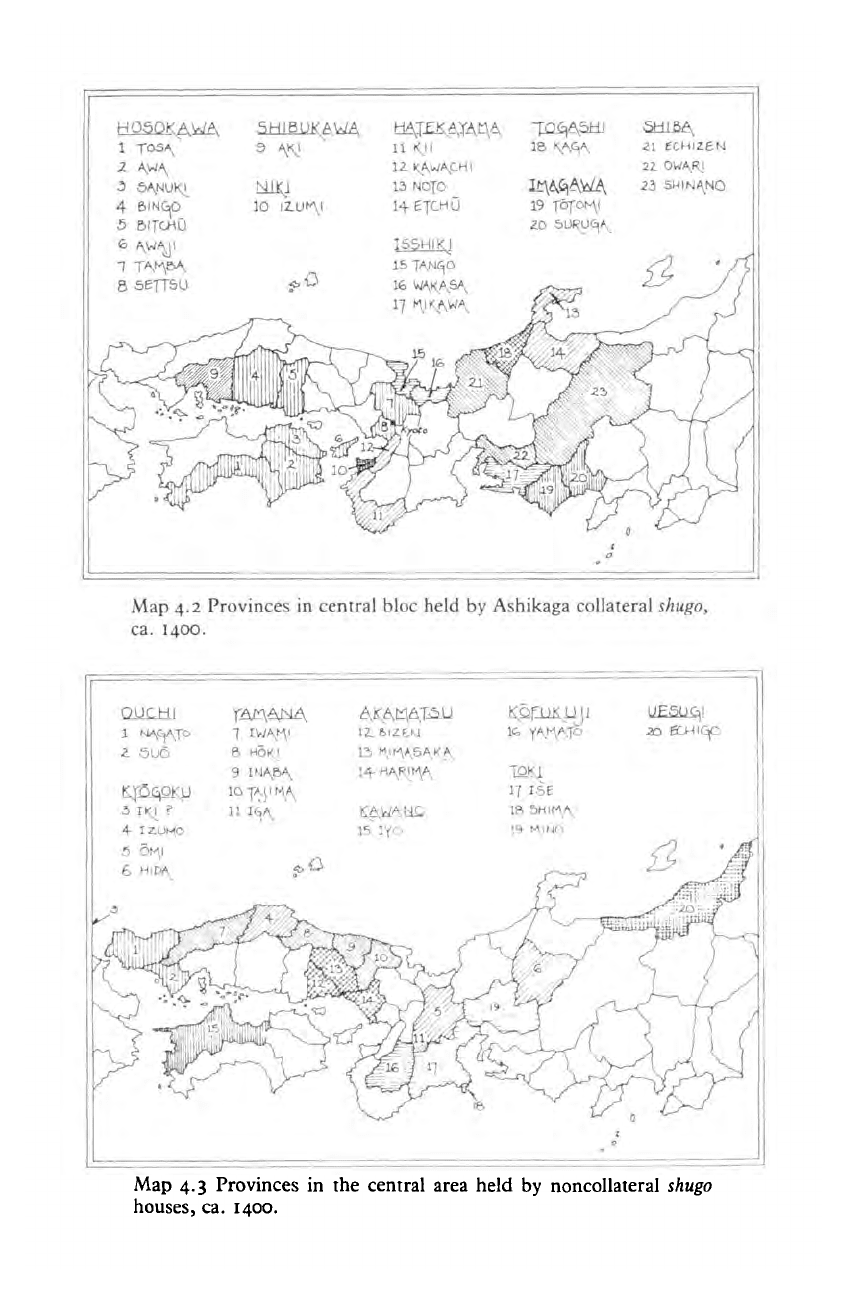
H050l<A>/A .SHIBUKT^WA.
SHIBA^
.21 gCWZEN
22.
OWA.RJ
23 SHIN^NO
Map 4.2 Provinces in central bloc held by Ashikaga collateral shugo,
ca. 1400.
nuci-ji
1 NAfyyjo
Z. 5U6
3 riq ?
4- IZJJHP
5 ON\l
YA.^\AJ\I^
7
IWAI^I
6 HOK^I
9 IMA.BA,
10-pyiN\A^
11 1^
^^^^
nL_J_ /
i^liliiiir^v
V
A
12.
BIZEM
15
15
;<» ^%
5-<-
I /^
•~S
IS
IS
17
18
19
\"^
IS
YAtycic
(AINO
r^"—
B/
5 3D g»IGp
1 y
CTK(
IP 1>J
is
0
1*^
t
0
o
Map 4.3 Provinces in the central area held by noncollateral shugo
houses, ca. 1400.
Cambridge Histories Online © Cambridge University Press, 2008
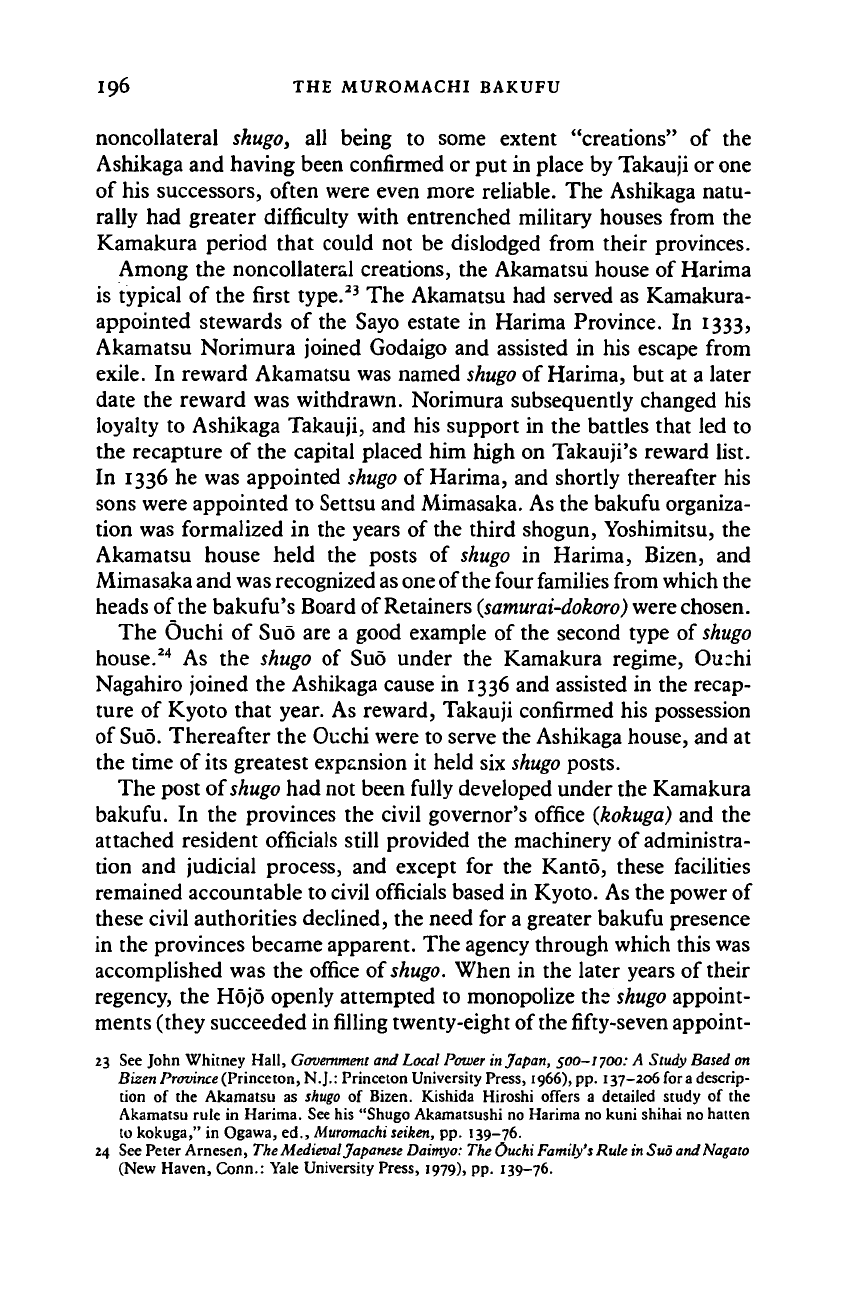
196 THE MUROMACHI BAKUFU
noncollateral shugo, all being to some extent "creations" of the
Ashikaga and having been confirmed or put in place by Takauji or one
of his successors, often were even more reliable. The Ashikaga natu-
rally had greater difficulty with entrenched military houses from the
Kamakura period that could not be dislodged from their provinces.
Among the noncollateral creations, the Akamatsu house of Harima
is typical of the first type.
23
The Akamatsu had served as Kamakura-
appointed stewards of the Sayo estate in Harima Province. In 1333,
Akamatsu Norimura joined Godaigo and assisted in his escape from
exile. In reward Akamatsu was named
shugo
of Harima, but at a later
date the reward was withdrawn. Norimura subsequently changed his
loyalty to Ashikaga Takauji, and his support in the battles that led to
the recapture of the capital placed him high on Takauji's reward list.
In 1336 he was appointed
shugo
of Harima, and shortly thereafter his
sons were appointed to Settsu and Mimasaka. As the bakufu organiza-
tion was formalized in the years of the third shogun, Yoshimitsu, the
Akamatsu house held the posts of
shugo
in Harima, Bizen, and
Mimasaka and
was
recognized
as one
of
the
four families from which the
heads of the bakufu's Board of Retainers
(samurai-dokoro)
were chosen.
The Ouchi of Suo are a good example of the second type of
shugo
house.
24
As the shugo of Suo under the Kamakura regime, Ou;hi
Nagahiro joined the Ashikaga cause in 1336 and assisted in the recap-
ture of Kyoto that year. As reward, Takauji confirmed his possession
of
Suo.
Thereafter the Ouchi were to serve the Ashikaga house, and at
the time of its greatest expansion it held six
shugo
posts.
The post of
shugo
had not been fully developed under the Kamakura
bakufu. In the provinces the civil governor's office
(kokuga)
and the
attached resident officials still provided the machinery of administra-
tion and judicial process, and except for the Kanto, these facilities
remained accountable to civil officials based in Kyoto. As the power of
these civil authorities declined, the need for a greater bakufu presence
in the provinces became apparent. The agency through which this was
accomplished was the office of
shugo.
When in the later years of their
regency, the Hojo openly attempted to monopolize the
shugo
appoint-
ments (they succeeded in
filling
twenty-eight of the
fifty-seven
appoint-
23 See John Whitney Hall,
Government
and Local Power
in
Japan, 500-1700: A Study Based on
Bizen Province (Princeton, N.J.: Princeton University Press, 1966), pp. 137-206 fora descrip-
tion of the Akamatsu as shugo of Bizen. Kishida Hiroshi offers a detailed study of the
Akamatsu rule in Harima. See his "Shugo Akamatsushi no Harima no kuni shihai no hatten
to kokuga," in Ogawa, ed.,
Muromachi
seiken,
pp. 139-76.
24 See Peter Arnesen,
The
Medieval Japanese Daimyo:
The Ouchi Family's
Rule
in
Suo and Nagato
(New Haven, Conn.: Yale University Press, 1979), pp. 139-76.
Cambridge Histories Online © Cambridge University Press, 2008
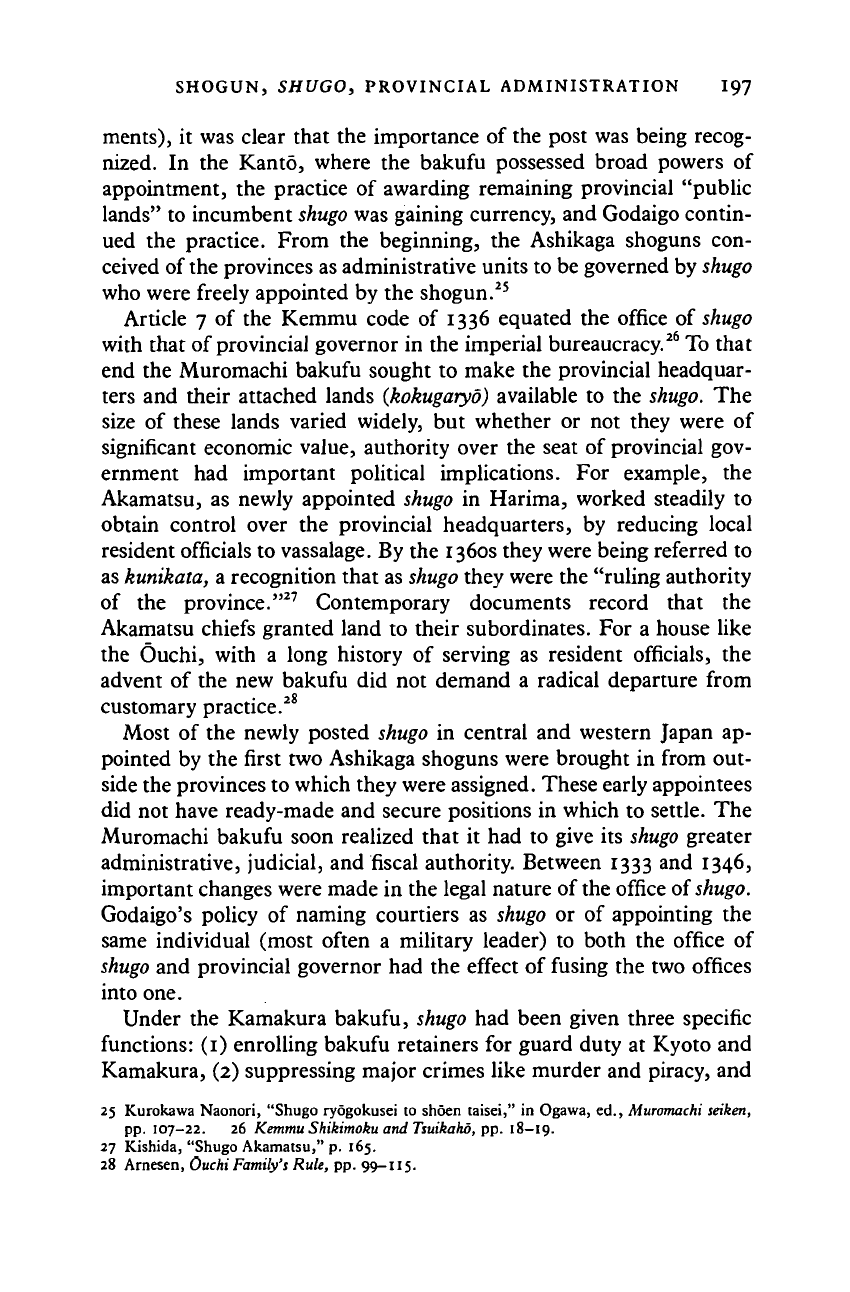
SHOGUN, SHUGO, PROVINCIAL ADMINISTRATION I97
ments),
it was clear that the importance of the post was being recog-
nized. In the Kanto, where the bakufu possessed broad powers of
appointment, the practice of awarding remaining provincial "public
lands"
to incumbent
shugo
was gaining currency, and Godaigo contin-
ued the practice. From the beginning, the Ashikaga shoguns con-
ceived of the provinces as administrative units to be governed by shugo
who were freely appointed by the shogun.
25
Article 7 of the Kemmu code of 1336 equated the office of shugo
with that of provincial governor in the imperial bureaucracy.
26
To that
end the Muromachi bakufu sought to make the provincial headquar-
ters and their attached lands (kokugaryo) available to the shugo. The
size of these lands varied widely, but whether or not they were of
significant economic value, authority over the seat of provincial gov-
ernment had important political implications. For example, the
Akamatsu, as newly appointed shugo in Harima, worked steadily to
obtain control over the provincial headquarters, by reducing local
resident officials to vassalage. By the 1360s they were being referred to
as kunikata, a recognition that as
shugo
they were the "ruling authority
of the province."
27
Contemporary documents record that the
Akamatsu chiefs granted land to their subordinates. For a house like
the Ouchi, with a long history of serving as resident officials, the
advent of the new bakufu did not demand a radical departure from
customary practice.
28
Most of the newly posted shugo in central and western Japan ap-
pointed by the first two Ashikaga shoguns were brought in from out-
side the provinces to which they were assigned. These early appointees
did not have ready-made and secure positions in which to settle. The
Muromachi bakufu soon realized that it had to give its shugo greater
administrative, judicial, and fiscal authority. Between 1333 and 1346,
important changes were made in the legal nature of the office of shugo.
Godaigo's policy of naming courtiers as shugo or of appointing the
same individual (most often a military leader) to both the office of
shugo and provincial governor had the effect of fusing the two offices
into one.
Under the Kamakura bakufu, shugo had been given three specific
functions: (1) enrolling bakufu retainers for guard duty at Kyoto and
Kamakura, (2) suppressing major crimes like murder and piracy, and
25 Kurokawa Naonori, "Shugo ryogokusei to shoen taisei," in Ogawa, ed., Muromachi seiken,
pp.
107-22. 26 Kemmu Shikimoku and Tsuikaho, pp. 18-19.
27 Kishida, "Shugo Akamatsu," p. 165.
28 Arnesen, Ouchi Family's Rule, pp. 99-115.
Cambridge Histories Online © Cambridge University Press, 2008
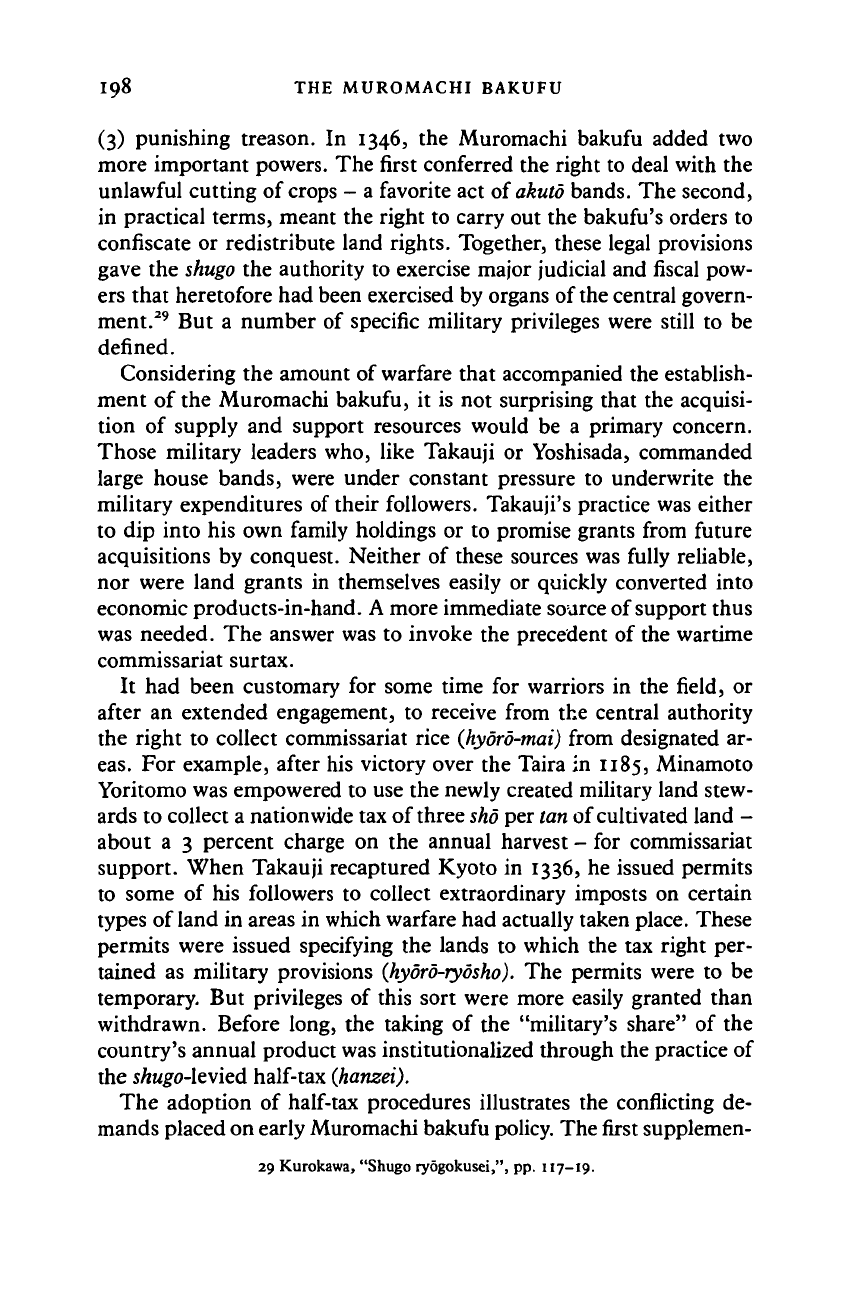
198 THE MUROMACHI BAKUFU
(3) punishing treason. In 1346, the Muromachi bakufu added two
more important powers. The first conferred the right to deal with the
unlawful cutting of crops - a favorite act of
akuto
bands. The second,
in practical terms, meant the right to carry out the bakufu's orders to
confiscate or redistribute land rights. Together, these legal provisions
gave the
shugo
the authority to exercise major judicial and fiscal pow-
ers that heretofore had been exercised by organs of
the
central govern-
ment.
29
But a number of specific military privileges were still to be
defined.
Considering the amount of warfare that accompanied the establish-
ment of the Muromachi bakufu, it is not surprising that the acquisi-
tion of supply and support resources would be a primary concern.
Those military leaders who, like Takauji or Yoshisada, commanded
large house bands, were under constant pressure to underwrite the
military expenditures of their followers. Takauji's practice was either
to dip into his own family holdings or to promise grants from future
acquisitions by conquest. Neither of these sources was fully reliable,
nor were land grants in themselves easily or quickly converted into
economic products-in-hand.
A
more immediate source of support thus
was needed. The answer was to invoke the precedent of the wartime
commissariat surtax.
It had been customary for some time for warriors in the field, or
after an extended engagement, to receive from the central authority
the right to collect commissariat rice
(hydro-mai)
from designated ar-
eas.
For example, after his victory over the Taira in 1185, Minamoto
Yoritomo was empowered to use the newly created military land stew-
ards to collect a nationwide tax of three
sho
per
tan
of cultivated land -
about a 3 percent charge on the annual harvest - for commissariat
support. When Takauji recaptured Kyoto in 1336, he issued permits
to some of his followers to collect extraordinary imposts on certain
types of land in areas in which warfare had actually taken place. These
permits were issued specifying the lands to which the tax right per-
tained as military provisions
(hyoro-ryosho).
The permits were to be
temporary. But privileges of this sort were more easily granted than
withdrawn. Before long, the taking of the "military's share" of the
country's annual product was institutionalized through the practice of
the shugo-levied half-tax (hatvzei).
The adoption of half-tax procedures illustrates the conflicting de-
mands placed on early Muromachi bakufu
policy.
The first supplemen-
29 Kurokawa, "Shugo ryogokusei,", pp. 117-19.
Cambridge Histories Online © Cambridge University Press, 2008
